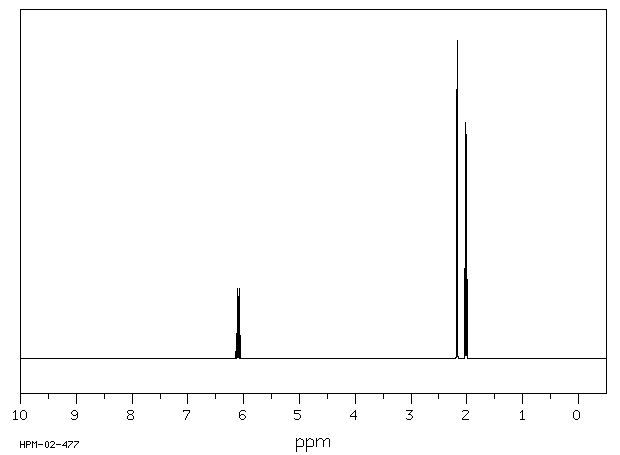(Z)-2-nitro-2-butene | 27748-49-8
分子结构分类
中文名称
——
中文别名
——
英文名称
(Z)-2-nitro-2-butene
英文别名
2-nitro-2-butene;(Z)-2-nitro-but-2-ene;Nitro-2-buten-2;2-Nitrobuten-2;(Z)-2-nitrobut-2-ene
CAS
27748-49-8
化学式
C4H7NO2
mdl
——
分子量
101.105
InChiKey
DAHZYRVPEHDLPG-ARJAWSKDSA-N
BEILSTEIN
——
EINECS
——
-
物化性质
-
计算性质
-
ADMET
-
安全信息
-
SDS
-
制备方法与用途
-
上下游信息
-
文献信息
-
表征谱图
-
同类化合物
-
相关功能分类
-
相关结构分类
计算性质
-
辛醇/水分配系数(LogP):1.3
-
重原子数:7
-
可旋转键数:0
-
环数:0.0
-
sp3杂化的碳原子比例:0.5
-
拓扑面积:45.8
-
氢给体数:0
-
氢受体数:2
上下游信息
-
上游原料
中文名称 英文名称 CAS号 化学式 分子量 —— (E)-2-nitrobut-2-ene 27748-48-7 C4H7NO2 101.105
反应信息
-
作为反应物:描述:参考文献:名称:Reaction of Carbanions Derived From α,β-Unsaturated Nitro Compounds With Electrophiles to Give α-Substituted Products摘要:α,β-不饱和硝基化合物与醛或电子缺乏的烯烃在碱的存在下反应,提供了一种制备α-取代烯丙基硝基化合物的简单方法。最初形成的烯丙基负离子选择性地在与硝基相邻的α位置反应。所形成的产物包括γ,δ-不饱和β-硝基醇2,以及δ,ε-不饱和γ-硝基酮、酯、腈和磺酰基化合物3,这些都可以作为有用的合成中间体。DOI:10.1055/s-1987-27907
-
作为产物:参考文献:名称:Descotes,G. et al., Bulletin de la Societe Chimique de France, 1970, p. 290 - 294摘要:DOI:
文献信息
-
Insights into the diastereoselective control in the sulfa-Michael addition of thiols to nitroalkenes: stereoelectronic effect in the cyclic chelated transition state作者:Jiandong Wang、Pingfan Li、Zhanhui Yang、Ning Chen、Jiaxi XuDOI:10.1016/j.tet.2015.11.030日期:2016.1two approximately 1,2-diaxial substituents due to stereoelectronic effect control. The stereoelectronic effect in the cyclic chelated transition state was probed and verified by tuning the steric bulkiness of the corresponding substituents. The reaction involving 1-nitrocyclohexene provided perfect support for the proposed diastereoselective control model. The current investigation provided not only
-
Regioselective Preparation of Allylic Sulfones by Palladium-Catalyzed Reactions of Allylic Nitro Compounds with Sodium Benzenesulfinate作者:Noboru Ono、Isami Hamamoto、Takashi Kawai、Aritsune Kaji、Rui Tamura、Masato KakihanaDOI:10.1246/bcsj.59.405日期:1986.2thermodynamically-stable isomers is negligible. On the other hand, the palladium-catalyzed sulfonylation of allylic acetates with sodium benzenesulfinate is accompanied by the isomerization to give the thermodynamically-controlled products selectively. These results can be explained by assuming that allylic nitro compounds are more reactive to the palladium catalyst than allylic acetates and sulfones.
-
A convenient procedure for the conversion of (E)-nitroalkenes to (Z)-nitroalkenes via erythro-β-nitroselenides作者:Noboru Ono、Akio Kamimura、Takashi Kawai、Aritsune KajiDOI:10.1039/c39870001550日期:——erythro-Selective conjugate addition of benzeneselenol to (E)-nitroalkenes and subsequent syn-elimination of benzeneselenenic acid provide a new method for the conversion of (E)-nitroalkenes into (Z)-nitroalkenes.赤-选择性共轭加成苯硒酚的至(ë)-nitroalkenes和随后顺benzeneselenenic酸的β-消除提供(转化的新方法ë)-nitroalkenes成(Ž)-nitroalkenes。
-
Benhaoua, Hadj; Piet, Jean-Claude; Danion-Bougot, Renee, Bulletin de la Societe Chimique de France, 1987, # 2, p. 325 - 338作者:Benhaoua, Hadj、Piet, Jean-Claude、Danion-Bougot, Renee、Toupet, Loic、Carrie, RobertDOI:——日期:——
-
ONO, NOBORU;KAMIMURA, AKIO;KAWAI, TAKASHI;KAJI, ARITSUNE, J. CHEM. SOC. CHEM. COMMUN.,(1987) N 20, 1550-1551作者:ONO, NOBORU、KAMIMURA, AKIO、KAWAI, TAKASHI、KAJI, ARITSUNEDOI:——日期:——
表征谱图
-
氢谱1HNMR
-
质谱MS
-
碳谱13CNMR
-
红外IR
-
拉曼Raman
-
峰位数据
-
峰位匹配
-
表征信息
同类化合物
顺式-2-硝基环己基乙酸酯
顺式-2-硝基-6-甲基环己酮
雷尼替丁杂质18
铝硝基甲烷三氯化物
钾离子载体III
重氮(硝基)甲烷
醛基-七聚乙二醇-叠氮
过氧亚甲基
辛腈,4-氟-4-硝基-7-羰基-
辛烷,1,2-二氯-1-硝基-
赤霉素A4+7(GA4:GA7=65:35)
苄哒唑
羟胺-四聚乙二醇-叠氮
羟胺-三乙二醇-叠氮
米索硝唑
磷酸十二醇酯
碘硝基甲烷
碘化e1,1-二甲基-4-羰基-3,5-二(3-苯基-2-亚丙烯基)哌啶正离子
硝酰胺
硝基脲银(I)复合物
硝基甲醇
硝基甲烷-d3
硝基甲烷-13C,d3
硝基甲烷-13C
硝基甲烷-(15)N
硝基甲烷
硝基甲基甲醇胺
硝基环辛烷
硝基环戊烷
硝基环戊基阴离子
硝基环庚烷
硝基环己烷锂盐
硝基环己烷钾盐
硝基环己烷
硝基环丁烷
硝基氨基甲酸
硝基新戊烷
硝基二乙醇胺
硝基乙醛缩二甲醇
硝基乙醛缩二乙醇
硝基乙腈
硝基乙烷-D5
硝基乙烷-1,1-d2
硝基乙烷
硝基乙烯
硝基丙烷
硝基丙二醛(E,E)-二肟
硝基丙二腈
硝基-(3-硝基-[4]吡啶基)-胺
硝乙醛肟







